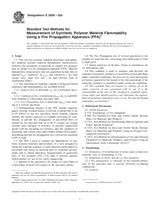Wir benötigen Ihre Einwilligung zur Verwendung der einzelnen Daten, damit Sie unter anderem Informationen zu Ihren Interessen einsehen können. Klicken Sie auf "OK", um Ihre Zustimmung zu erteilen.
ASTM E2058-02a
Standard Test Methods for Measurement of Synthetic Polymer Material Flammability Using a Fire Propagation Apparatus (FPA) (Includes all amendments And changes 3/2/2021).
Automatische name übersetzung:
Standard-Prüfverfahren für Messung aus synthetischem Polymermaterial Entflammbarkeit Mit einer Brandausbreitung Vorrichtung (FPA)
NORM herausgegeben am 10.10.2002
Informationen über die Norm:
Bezeichnung normen: ASTM E2058-02a
Anmerkung: UNGÜLTIG
Ausgabedatum normen: 10.10.2002
SKU: NS-44129
Zahl der Seiten: 29
Gewicht ca.: 87 g (0.19 Pfund)
Land: Amerikanische technische Norm
Kategorie: Technische Normen ASTM
Die Annotation des Normtextes ASTM E2058-02a :
Keywords:
effective heat of combustion, fire propagation apparatus, flammability characteristics, upward fire propagation, ICS Number Code 13.220.40 (Ignitability and burning behaviour of materials and products),59.060.20 (Man-made fibres)
Ergänzende Informationen
| 1. Scope | ||||||||||
|
1.1 This fire-test-response standard determines and quantifies synthetic polymer material flammability characteristics, related to the propensity of materials to support fire propagation, by means of a fire propagation apparatus (FPA). Material flammability characteristics that are quantified include time to ignition (tign), chemical ( Qchem), and convective ( Qc) heat release rates, mass loss rate ( m) and effective heat of combustion (EHC). 1.2 The following test methods, capable of being performed separately and independently, are included herein: 1.2.1 Ignition Test, to determine tign for a horizontal specimen; 1.2.2 Combustion Test, to determine Qchem, Qc'm, and EHC from burning of a horizontal specimen; and, 1.2.3 Fire Propagation Test to determine Qchem from burning of a vertical specimen. 1.3 Distinguishing features of the FPA include tungsten-quartz external, isolated heaters to provide a radiant flux of up to 65 kW/m 2 to the test specimen, which remains constant whether the surface regresses or expands; provision for combustion or upward fire propagation in prescribed flows of normal air, air enriched with up to 40 % oxygen, air oxygen vitiated, pure nitrogen or mixtures of gaseous suppression agents with the preceding air mixtures; and, the capability of measuring heat release rates and exhaust product flows generated during upward fire propagation on a vertical test specimen 0.305 m high. 1.4 The FPA is used to evaluate the flammability of synthetic polymer materials and products. It is also designed to obtain the transient response of such materials and products to prescribed heat fluxes in specified inert or oxidizing environments and to obtain laboratory measurements of generation rates of fire products (CO2, CO, and, if desired, gaseous hydrocarbons) for use in fire safety engineering. 1.5 Ignition of the specimen is by means of a pilot flame at a prescribed location with respect to the specimen surface. 1.6 The Fire Propagation test of vertical specimens is not suitable for materials that, on heating, melt sufficiently to form a liquid pool. 1.7 Values stated are in SI units. Values in parentheses are for information only. 1.8 This standard is used to measure and describe the response of materials, products, or assemblies to heat and flame under controlled conditions, but does not by itself incorporate all factors required for fire hazard or fire risk assessment of the materials, products or assemblies under actual fire conditions. 1.9 This standard does not purport to address all of the safety concerns, if any, associated with its use. It is the responsibility of the user of this standard to establish appropriate safety and health practices and determine the applicability of regulatory limitations prior to use. For specific hazard statements, see Section 7. |
||||||||||
| 2. Referenced Documents | ||||||||||
|
Empfehlungen:
Aktualisierung der Gesetze
Wollen Sie sich sicher sein, dass Sie nur die gültigen technischen Vorschriften verwenden?
Wir bieten Ihnen Lösungen, damit Sie immer nur die gültigen (aktuellen) legislativen Vorschriften verwenden könnten.
Brauchen Sie mehr Informationen? Sehen Sie sich diese Seite an.




 Cookies
Cookies
